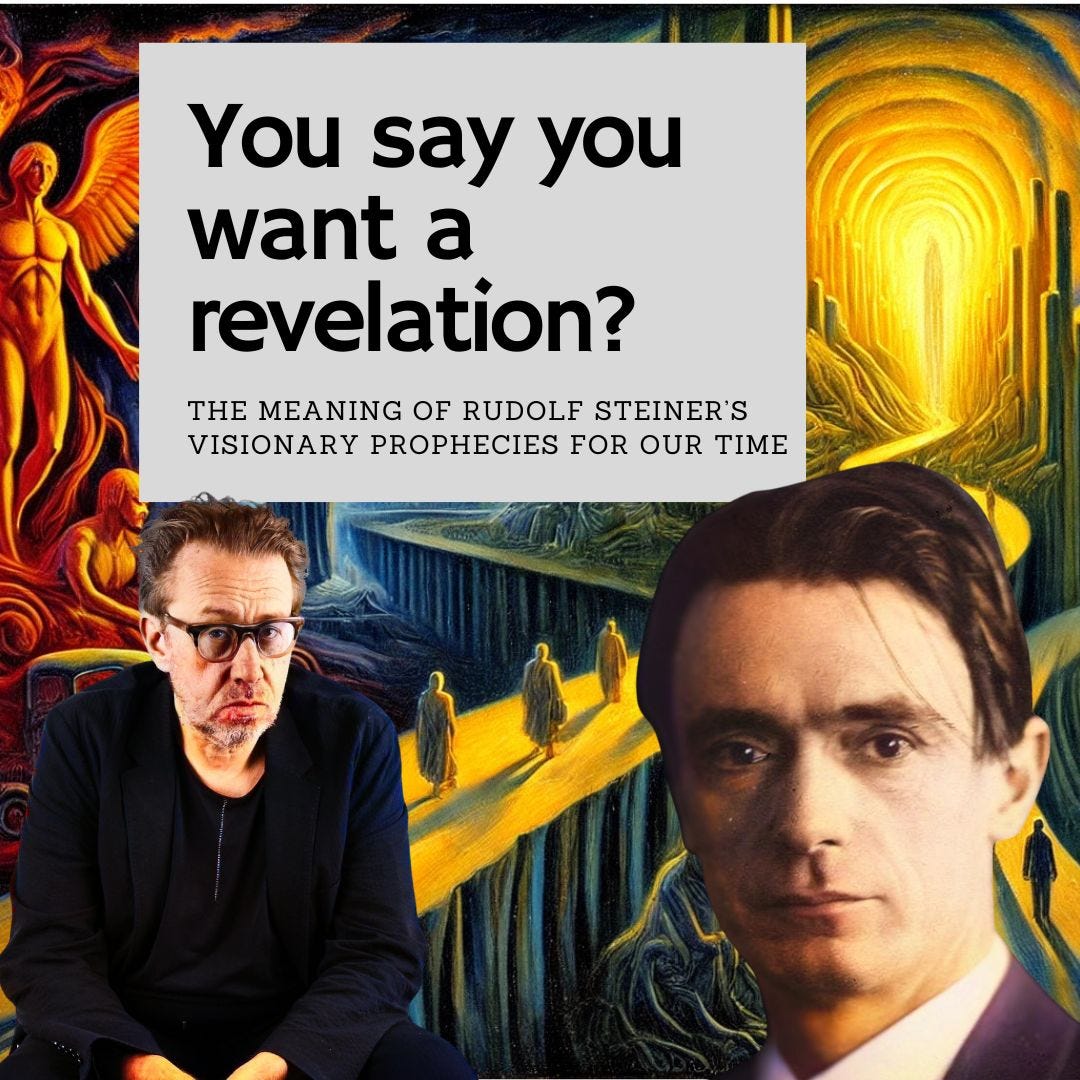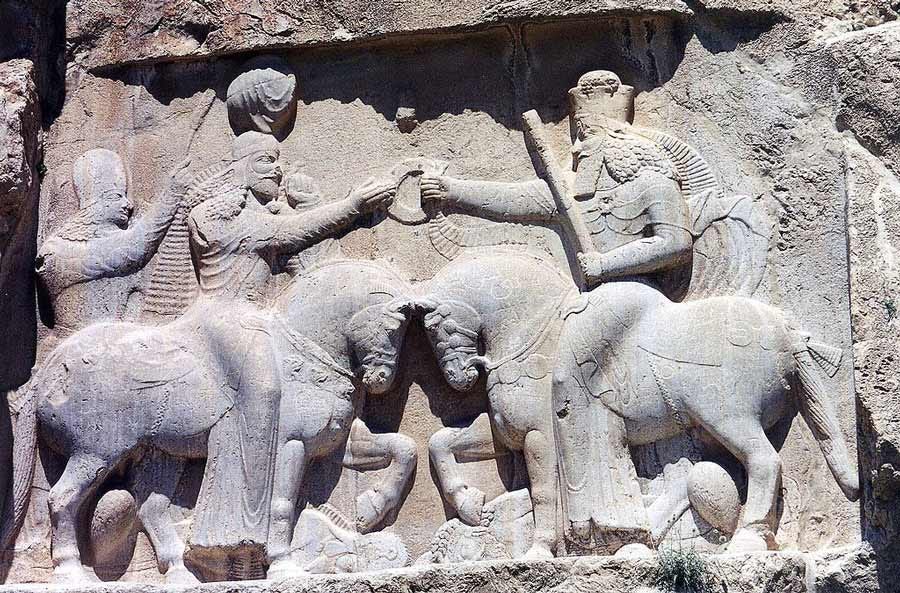The Symphony of the Creative Word
In Rudolf Steiner's cosmological vision, nature is meaning made visible
You Say You Want A Revelation?
Feb. 22 - March 20, 2025
A month-long exploration of Rudolf Steiner’s visionary thinking and his profound relevance for our time. We’ll delve into Steiner’s revolutionary ideas on consciousness, spiritual evolution, and humanity’s cosmic destiny. Learn how his synthesis of Christianity, Eastern philosophy, and animist worldviews offers a redemptive framework for navigating today’s crises, from the rise of AI to the psychedelic renaissance. Through sessions on his life, influences, cosmology, and legacy, discover why Steiner’s teachings on reincarnation, karmic relationships, and the other dimensions remain essential. Discount tickets available for paid subscribers.
Over the last months, I have been hyper-focused on what is unfolding in the US as an “administrative coup” or possibly something worse. I feel it is even more important, confronting this emergency for humanity and the Earth, that we pull back to rediscover the kind of thinking that redeems and ennobles our daily lives. Steiner offers a holistic and revelatory occult philosophy that can, potentially (if we take seriously the Buddha’s famous dictum, “as perceived, so appears”), transform the nature of reality itself.
Personally, I believe Steiner (1861 - 1925) offers us deep insights into what we are experiencing now. He predicted an upcoming, world-shattering event he called the “incarnation of Ahriman.” Steiner’s idea of Ahriman comes from the figure of Angra Mainyu (also called Ahriman) in Zoroastrianism, the ancient Persian religion. Ahriman is the destructive spirit of darkness and lies, locked in eternal struggle with Ahura Mazda, the spirit of light and truth.
For Steiner, Ahriman exists as one pole in a spiritual tension: He counterbalances Lucifer, the exalted yet dangerous being who tempts humanity towards pride, spiritual inflation, beauty, arrogance, and escape into illusion. Ahriman, by contrast, drags the human soul down toward the realm of dead matter, calculation, and rigid systems. Humanity’s task, according to Steiner, is not to reject either of these forces but to maintain them in balance—integrating Ahriman’s sharp intellect without losing our connection to the living, spiritual cosmos.
Ahriman's influence, Steiner suggested, would culminate in an age dominated by machines, rigid systems, and the reduction of human life to economic and technical efficiency (sound familiar?). As I see the rise of techno-feudalism, the pursuit of Artificial Super Intelligence, and the drive toward robotics and transhumanism, I am convinced his prophecy is materializing in our time. According to Steiner, the great danger of Ahriman’s incarnation is that we lose our souls to the hyper-efficient machine world — but of course, many people don’t believe they have a soul: They eagerly anticipate their assimilation into the Silicon super-mind.
In his many lectures and books, Rudolf Steiner elaborated on a profound vision of the cosmos, which he considers as consciousness, or as a vast, living, sentient being. We can gain a new level of insight into Steiner if we provisionally adopt the paradigm of monistic idealism, cogently argued by philosopher Bernardo Kastrup and neuroscientist Donald Hoffman, among others. Through this framework, Steiner’s vision in which the physical universe expresses the Logos as a “creative symphony” starts to resonate and to make sense in powerful, unexpected, and deeply satisfying ways.
Steiner sees the universe as an expression of what the Bible calls Logos: the creative word, an underlying meta-cosmic intelligence or unified field of consciousness that “speaks” through the physical and natural universe surrounding us. For him, this universe is not vacuous, sterile, or mechanical: It is the tangible expression of a living sentience. Logos is the divine Word in which we all participate, whether we know it or not.
To understand what he calls the “symphony of the creative word,” we must go beyond our purely rational faculties to attain an aesthetic, proprioceptive understanding. “You cannot deal with man through logic alone,” Steiner writes, “but through an understanding that can only be reached when intellect shall see the world as a work of art.” He doesn’t mean this as metaphor. Steiner proposes that every cloud, every bird, every breeze, every wave rippling on the oceans articulates this underlying cosmic sentience, of which we are an indivisible part.
Nature is meaning made visible. We exist as part of a vast orchestration in which we ourselves are tones—each being, each form, plays its part, expresses its necessary note, in an ever-unfolding harmony. This is, of course, what many indigenous and animist traditions tell us about the nature of reality. When I visited the Kogi and Aruak people in Colombia, they said that “nature is like a book,” which you can learn to read, full of correspondences and divinatory hints. If a bird flies into your room with a butterfly in its mouth, it might be letting you know that your grandparent has fallen ill in a distant village, if you have the intuitive capacity to read the sign.
Steiner invites us to see the human being as a microcosm containing within himself the structural principles of the entire macrocosm. He doesn’t offer this as a dry, intellectual schema. He wants us to enter into it — to experience and embody it.
In his 1923 lecture series, Man as Symphony of the Creative Word, Steiner explored how, as he perceived it from his spiritual vision, various beings of the Earth reflected cosmic processes that are also found within the human being (the microcosm). He starts with an esoteric investigation into the eagle, the lion, and the cow. In Steiner’s vision, these beings express and reveal cosmic forces that constantly work through our own physical and mental processes.
For instance, the eagle: As Steiner understands it, the eagle, in its being, gives expression to a specific spiritual force: The formative power of thought. The eagle is so permeated by the sun-irradiated air and the cosmic heights that its entire form is a metamorphosis of the “head-principle.” Steiner says, “The eagle has his plumage… in these lives the self-same force which lives in you in that you make your brain into the bearer of thoughts.” The eagle’s feathers are thoughts made visible; our thoughts are an inner plumage, an astral corollary to the eagle’s sun-wrought colors. Steiner finds an intrinsic relationship to our mental processes, our thoughts, in how birds have their plumage or feathers. If we pause to consider it, he notes, we know when we think like an eagle, a peacock, or a sparrow.
America identifies with the eagle, according to Steiner, because our culture is particularly attuned to the eagle-force—as a cosmic principle, this symbolizes the head, intellect, and abstract thought. Soaring above the earth, the eagle embodies humanity’s capacity to form thoughts detached from the heaviness of materiality. Steiner believed that in the West — especially America — this force exerts a one-sided influence, leading to a civilization dominated by technology and commerce, ruled by the false belief that reality can be constructed and mastered purely through intellect. The final result is technocratic rationalism that seeks control over nature while forfeiting deeper participation in the cosmos as a living whole.
The lion, by contrast, embodies the rhythm, breath, and blood. He is the radiant heart of the cosmos, a solar beast whose strength lies in the equilibrium between breath and pulse. Steiner marvels at the lion’s gaze, “from which so much looks out, something of inner mastery, the mastery of opposing forces.” In the lion’s rhythmic vitality, Steiner sees an image of the human heart and lungs—our own inner lion. This is not simply analogy. He means that the same cosmic breath, the same balancing solar pulse, creates both the lion’s strength and the human breast.
Steiner looks at the cow as the earth-bound vessel of digestion, will, and weight—a lunar, maternal creature whose heaviness expresses a form of divinity. Her rumination is not dull but sublime, as her digestive processes embody the cosmos in flesh, working out the astral rhythms of the universe in the slow churn of her organs. “The cow becomes beautiful in the process of digestion,” Steiner insists. To the spiritual eye, her metabolic processes glow with the radiance of cosmic wisdom. The ox represents the human limb-system, our capacity to act upon the earth, to shape matter with our will. According to Steiner, if cows and oxen didn’t exist, the Earth would soon become so hard that we would not be able to walk on it.
These animals are not merely symbolic in any decorative sense; they are condensed manifestations of the same spiritual forces that shape our thinking, feeling, and willing. “Man is in truth the synthesis of eagle, lion, and ox,” he writes. This is an example of Steiner’s practice of “imaginative knowledge:” a form of cognition in which thought becomes as vivid and immediate as sense perception. He offers us a way of seeing the world — and being in the world — in which our intellect becomes, once again, artistic, pictorial, creative.
Steiner’s vision is notoriously difficult for modern minds steeped in scientific reductionism to grasp. The bridge is monistic idealism, which sees consciousness as the fundamental reality, and the physical universe as the expression of that source-field of consciousness. Bernardo Kastrup, among others, argues that the material world is a shared dream arising within the transpersonal field of consciousness. With this framework, Steiner’s idea begins to make intuitive sense. If the world is the articulation of “Mind at Large,” in Aldous Huxley’s phrase, then why wouldn’t animals, plants, and stars be the embodied thoughts and feelings of that mind? Why wouldn’t the eagle’s flight express cosmic intellect, the lion’s breath embody solar courage, the cow’s digestion anchor the will of the earth?
As we find in Kastrup’s philosophy or in quantum physics (which has proved the universe is “not locally real”), Steiner’s cosmos is not made, finally, of atoms and stuff: It is formed out of intentions, expressions, correspondences. The eagle is not a bird. It is thought made flesh. The lion is not a predator. It is pure courage and will in physical form. The cow is not mere livestock. It is the physical expression of cosmic processes of digestion and rumination. Each is a tone in the complex harmony of the Logos: visible thoughts in the dreaming mind, apparitions of the infinite grace of the psycho-cosmos.
This way of seeing challenges the contemporary mind because it demands a reversal. We are trained to think that thoughts emerge from matter. Steiner and monistic idealism suggest the opposite: matter emerges from thoughts. Our individual consciousness is not a random expression of neurons. Our thoughts are microcosmic sparks thrown off by the same cosmic consciousness that forms the eagle’s feathers, the lion’s heart, the Sun’s warmth. We do not impose meaning on a meaningless world; we decipher the meaning that is already there, latent in the forms of nature, embedded in the deep poetic structure of being, because the world is mind speaking to itself.
Keep reading with a 7-day free trial
Subscribe to Liminal News With Daniel Pinchbeck to keep reading this post and get 7 days of free access to the full post archives.





